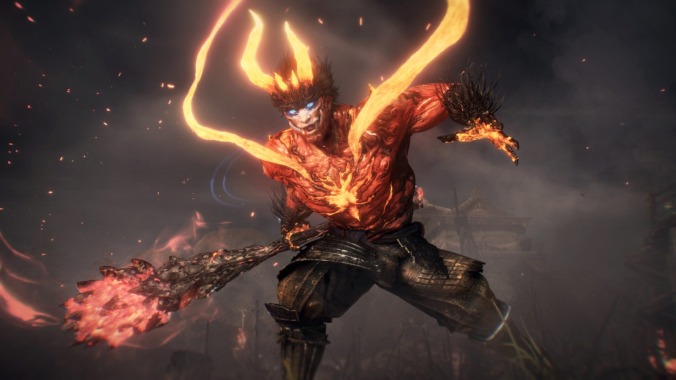Nioh 2’s inventory system is hot, glutted garbage

Every Friday, A.V. Club staffers kick off our weekly open thread for the discussion of gaming plans and recent gaming glories, but of course, the real action is down in the comments, where we invite you to answer our eternal question: What Are You Playing This Weekend?
Let’s be very clear: This is not a review of Nioh 2, the new character action game from Sony and Team Ninja. If you’d like to read one of those, they are, blessedly, not rare on the internet at the moment—although you could also just go back and read our 2017 review of Nioh 1, since the new title and its direct predecessor are stunningly similar games. (To be fair, the addition of a character creator, complete with the ability to paint your own teeth green in pursuit of Monster Factory weirdness, is a nice addition.) No, this is not a review of Nioh 2; rather, it’s a review of the inventory system of Nioh 2. Here’s the review: It fucking sucks.
This is also not new. The item system in the original Nioh—which, like this game, is a perfectly competent, sometimes even thrilling, action game, other issues aside—was absolutely terrible. Every enemy soldier or hulking demon lurking across the landscape of 17th-century Japan was a Secret Piñata, just waiting to explode into a nigh-identical cascade of boots, swords, and random drops that players were then obligated to scoop up to confusedly peruse at a later date. In its efforts to translate the Diablo/Borderlands loot box model to a game so closely modeled on the Dark Souls “slow-moving action” template, Team Ninja managed to make something that invoked the worst of both worlds—and now they’ve done it all over again.
For example: Is this copy of “Nanban Greaves” better than the other three I’ve already picked up in the last 20 minutes? Well, let’s see: Its rarity color is different, although that’s not always an indicator of quality. And its level is a little higher, although that doesn’t automatically translate into more defense. Does 1.5 percent extra money dropped compensate for losing 0.7 percent damage when attacking with my weak attack while in my High sword stance? Am I keeping track of which of its skills I can pass on to other weapons through the game’s equally obtuse crafting system? Does it match my ensemble? Am I being good, Daddy? Am I achieving optimal equipment loadout? Am I being good?
In a first draft game like the original Nioh, this was just barely acceptable—even if, as we noted at the time, it also created a problem wherein the developers lose their ability to properly tune different parts of the game’s difficulty, because god knows what stat boosters have actually dropped into any given player’s lap. But to look at this system and say, “Yes, good, more of this again” with a sequel is absolutely baffling. At the very least, you’d expect them to increase the game’s inventory limit to reduce the amount of time—often several minutes per session!—that players spend clearing utter garbage out of their giant rucksacks of shit whenever it gets filled to the brim. This is one of the only games ever created in which an “enemies drop more equipment” upgrade is less of a buff, and more of a threat. Even for players who find this kind of number-comparing minutiae thrilling, Nioh 2 is an exercise in overwhelm. And sure, you could just not pick the stuff up. But that runs counter to every instinct video games have been instilling in players for years.
It’s also a symptom of Nioh 2 as a whole, a legitimately fun game that’s so hopped up on its addiction to systems that it frequently threatens to descend into mere gaming white noise. When every enemy drops an item with a big blue arrow slapped on it—when every new drop promises to be the answer to all your problems—it becomes a numbing slog in its own right. It’s not even too much of a good thing. It’s just too much crap, a problem that, like so much of what keeps Nioh 2 from being a truly great game, isn’t very new at all.